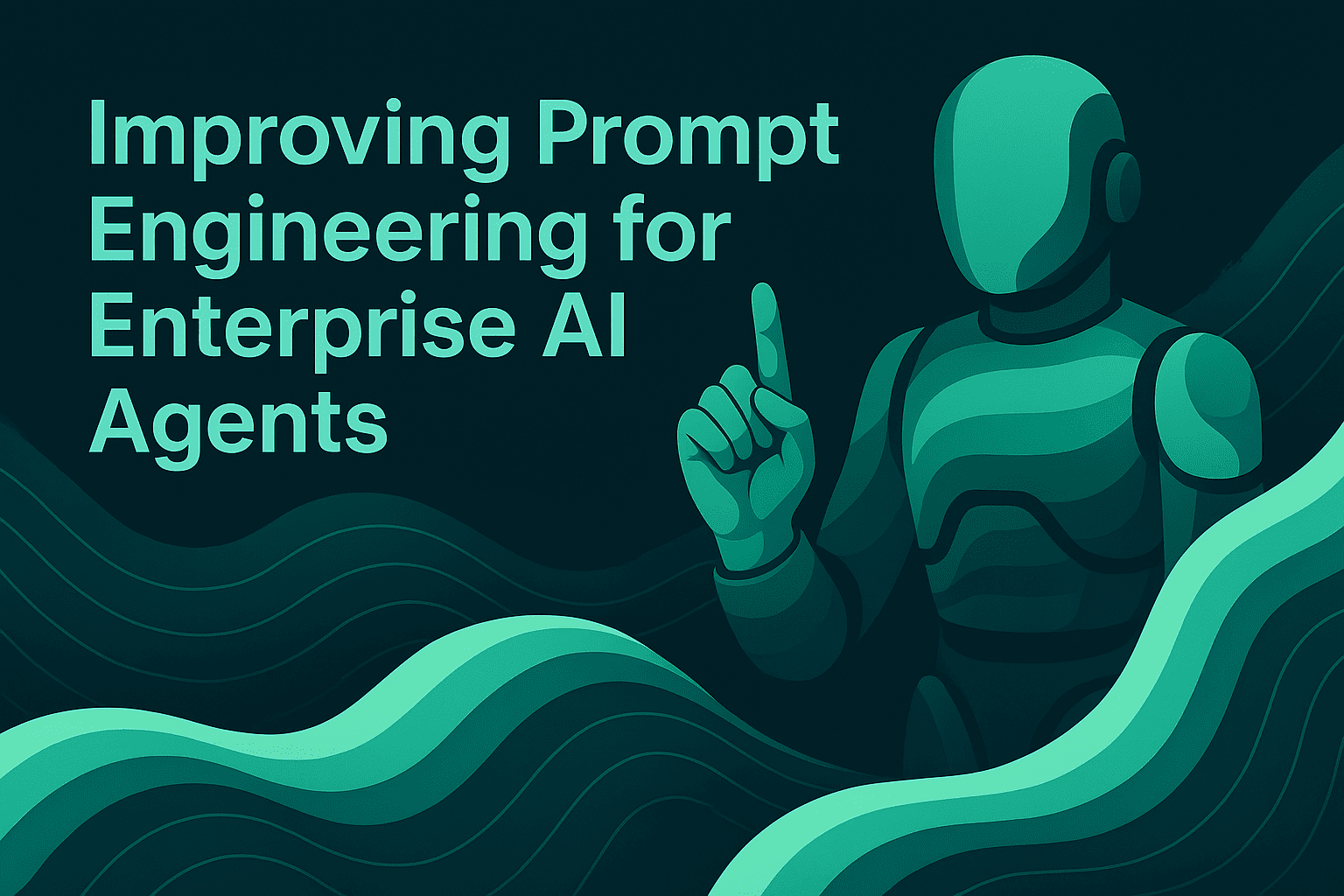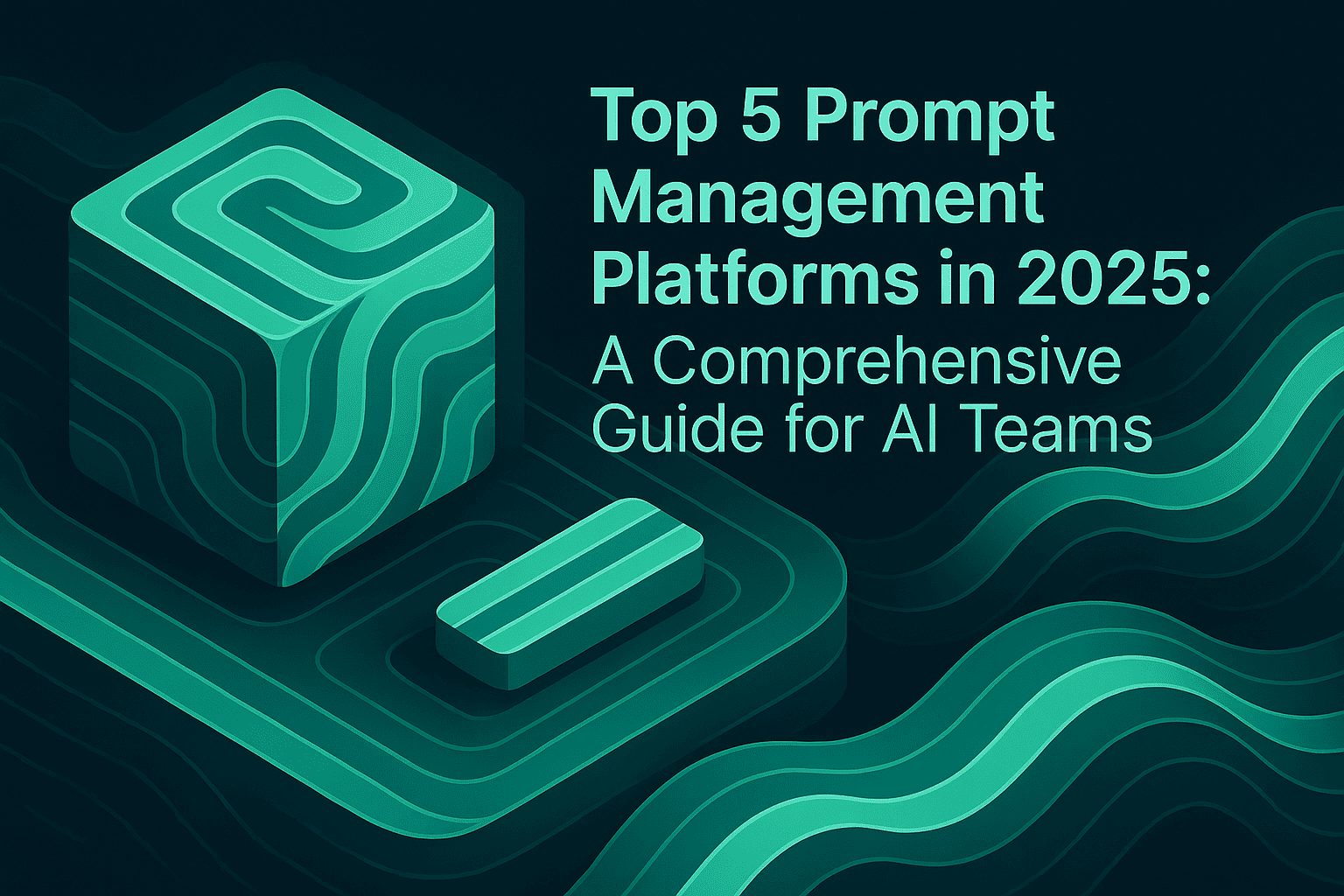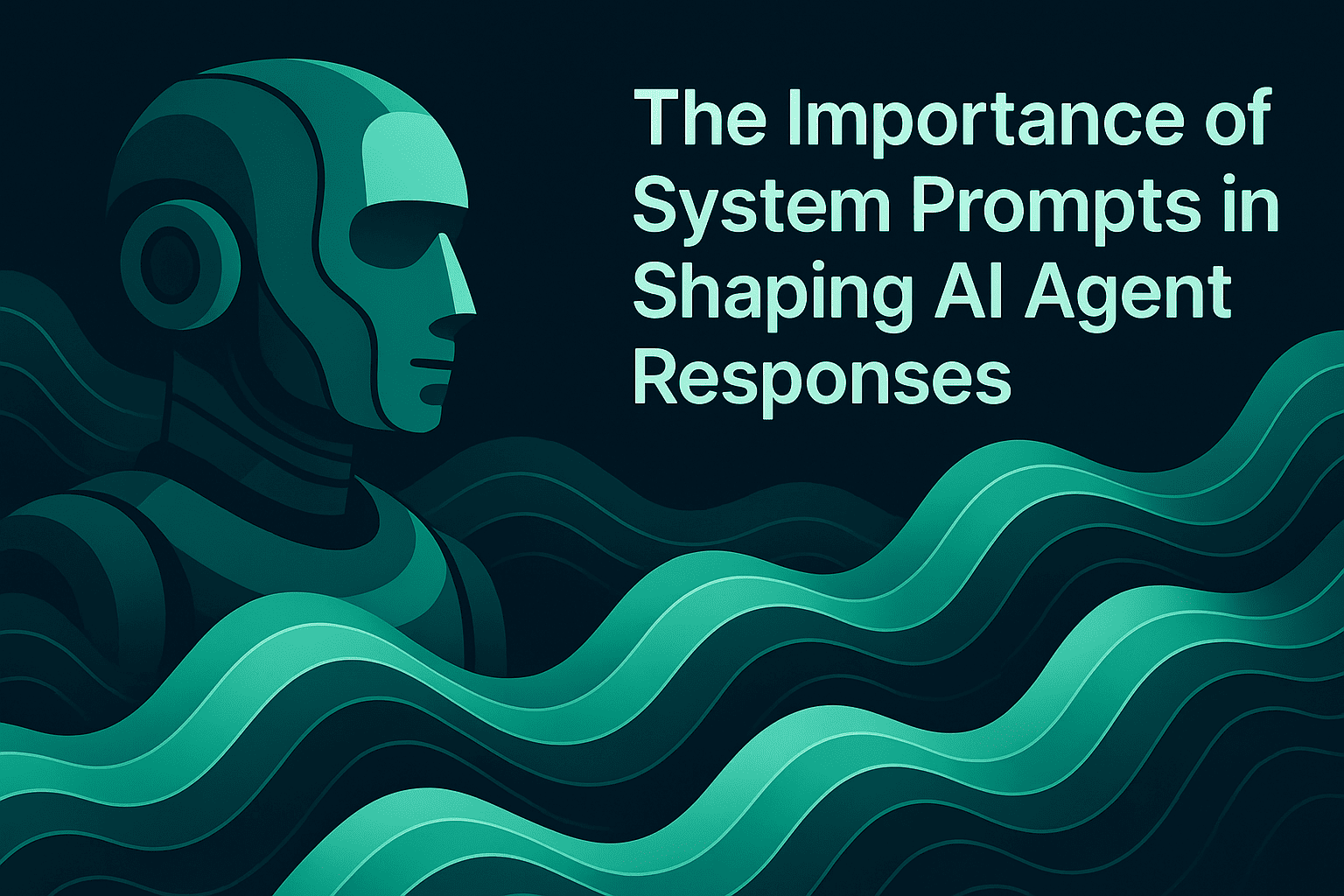Improving Prompt Engineering for Enterprise AI Agents

Prompt engineering has evolved from a niche technical skill to a critical competency for enterprise AI deployment. The challenge isn't just crafting the perfect prompt, it's thoughtfully curating what information enters the model's limited attention budget at each step. As organizations transition from proof-of-concept pilots to production-scale AI agents, the quality and precision of prompt engineering directly impacts system reliability, accuracy, and business outcomes.
A recent survey of over 1,000 enterprise technology leaders revealed that 42% of enterprises need access to eight or more data sources to deploy AI agents successfully, with security concerns emerging as the top challenge. These integration complexities underscore why effective prompt engineering requires more than just writing good instructions, it demands a systematic approach to context management, tool integration, and continuous optimization.
Understanding Context Engineering for AI Agents
Context engineering has emerged as the new frontier, shifting focus from finding the right words and phrases for prompts to answering the broader question of what configuration of context is most likely to generate desired model behavior. This evolution reflects a fundamental truth about working with large language models: they operate within finite context window limits.
The Core Principle of Effective Context Management
Given that LLMs are constrained by a finite attention budget, good context engineering means finding the smallest possible set of high-signal tokens that maximize the likelihood of some desired outcome. This principle applies across all components of an agent's context window:
- System prompts that provide clear, altitude-appropriate guidance
- Tool definitions that explain functionality without excessive verbosity
- Examples that demonstrate expected behavior efficiently
- Message history that preserves relevant context while managing token limits
Avoiding Common Pitfalls in System Prompts
System prompts should be extremely clear and use simple, direct language that presents ideas at the right altitude for the agent, finding the Goldilocks zone between hardcoding complex, brittle logic and providing vague, high-level guidance that fails to give concrete signals. Many enterprise teams fall into one of two extremes:
- Organizations that hardcode overly specific logic create fragile systems that require constant maintenance as edge cases emerge.
- Conversely, teams providing only abstract guidance leave too much to interpretation, resulting in unpredictable agent behavior.
Advanced Prompting Techniques for Production Systems
Chain-of-Thought Reasoning and ReAct Patterns
Advanced techniques like Chain-of-Thought and ReAct improve reasoning capabilities by up to 37% in specialized tasks. These patterns encourage models to break down complex problems into intermediate steps, making their reasoning process more transparent and reliable.
A ReAct-powered cybersecurity agent deployed at a Fortune 500 company reduced false positive alerts by 44%, demonstrating how structured reasoning patterns translate to measurable operational improvements. The ReAct framework combines reasoning traces with actions, allowing agents to dynamically adjust their approach based on observed outcomes.
Retrieval-Augmented Generation for Enterprise Knowledge
RAG has emerged as a critical technique for enhancing AI agent knowledge without complete retraining, with RAG integration reducing hallucinations by 55% in medical diagnosis applications. By connecting language models to external knowledge sources, RAG enables more accurate and verifiable outputs grounded in organizational data.
Academic researchers using RAG-enhanced prompts report 60% time savings in literature reviews by automatically connecting relevant sources. For enterprises, this capability is particularly valuable in customer relationship management and technical support scenarios where combining historical data with current context leads to more personalized and accurate interactions.
When implementing RAG for enterprise AI agents, consider integrating with Maxim's observability suite to monitor retrieval quality and track how external knowledge sources impact agent performance in production environments.
Few-Shot Learning and Example Selection
Few-shot prompting remains a well-known best practice that teams should continue to strongly advise, but rather than stuffing a laundry list of edge cases into a prompt, teams should curate a set of diverse, canonical examples that effectively portray expected agent behavior.
Effective few-shot prompting requires:
- Diversity: Examples should cover the range of expected inputs and desired outputs
- Canonicality: Each example should represent a prototypical case rather than edge scenarios
- Clarity: Examples must demonstrate both input handling and expected reasoning process
Quality trumps quantity in example selection. Five well-chosen examples often outperform twenty poorly selected ones while consuming fewer tokens and providing clearer signals to the model.
Prompt Engineering Best Practices for Enterprise Deployment
Clarity and Specificity in Instructions
Enterprise AI agents operate in complex environments where ambiguity translates directly to errors, compliance risks, and degraded user experiences.
Context is critical, ensure the agent has all necessary information since it cannot infer what's in your head. This means explicitly stating:
- The agent's role and capabilities
- Expected input and output formats
- Constraints and limitations
- Success criteria and quality standards
Employing affirmative directives such as 'do' while steering clear of negative language like 'don't' generally produces better results. Positive framing helps models understand desired behavior rather than forcing them to infer correct actions from a list of prohibited ones.
Iterative Testing and Validation
Prompt engineering enters diminishing returns territory without systematic evaluation. Enterprise teams must establish rigorous testing protocols that validate prompt performance across representative scenarios before production deployment.
Best practices for prompt evaluation include:
- Scenario-based testing: Create test cases that cover common paths, edge cases, and failure modes
- Regression detection: Monitor for unintended consequences when refining prompts
- Performance metrics: Track accuracy, latency, cost, and user satisfaction across prompt versions
- A/B testing: Compare prompt variants in controlled experiments to measure real-world impact
Leverage Maxim's experimentation platform to organize and version prompts directly from the UI, deploy different variants without code changes, and compare output quality, cost, and latency across various combinations systematically.
Structured Output and Formatting
Using delimiters like triple quotes can help the model better understand the distinct parts of your prompt. Structured formatting becomes increasingly important as agents handle complex multi-step workflows and integrate with downstream systems.
Consider these formatting techniques:
- XML or JSON schemas for structured data exchange
- Markdown headers to delineate logical sections
- Code blocks to separate examples from instructions
- Numbered steps for sequential workflows
When agents need to produce outputs consumed by other systems, specify exact formats and provide validation examples. This reduces parsing errors and integration failures in production environments.
Memory and Conversation Management
Since LLMs are stateless by default, you need to manage their history and context. Enterprise AI agents often engage in extended interactions where maintaining relevant context while managing token limits becomes critical.
Effective conversation management strategies include:
- Selective history compression: Retain critical information while summarizing less relevant exchanges
- Entity tracking: Maintain structured records of key entities (customers, products, issues) separately from conversation history
- Context windowing: Dynamically adjust included history based on available tokens and relevance
- State persistence: Store conversation state externally to enable session resumption and multi-channel consistency
Addressing Enterprise-Specific Challenges
Integration with Legacy Systems
More than 86% of enterprises require upgrades to their existing tech stack to deploy AI agents. Many organizations struggle to integrate agentic AI with legacy infrastructure that is often rigid, making it difficult for autonomous AI agents to plug in, adapt and orchestrate processes.
Prompt engineering in enterprise contexts must account for system limitations:
- API constraints: Design prompts that work within rate limits and response time requirements
- Data format incompatibilities: Include transformation logic in agent instructions when systems use different schemas
- Authentication and authorization: Incorporate security context into prompts while protecting sensitive credentials
- Error handling: Prepare agents for common failure modes in integrated systems
Security and Compliance Considerations
Prompt injection attacks represent a significant vulnerability, where malicious inputs can hijack AI functionality, but mitigation strategies focusing on input sanitization and adversarial testing have demonstrated 89% reduction in successful exploit rates.
Enterprise prompt engineering must incorporate security measures:
- Input validation: Define expected input patterns and reject anomalous requests
- Privilege limitations: Restrict agent capabilities to minimum required permissions
- Audit logging: Track agent decisions and actions for compliance and forensic analysis
- Guardrails: Implement content filtering and behavior constraints in system prompts
Effective security practices include implementing guardrails within prompts, validating inputs against known attack patterns, and limiting the scope of AI agent actions to prevent escalation of privileges.
Use Maxim's observability features to track, debug, and resolve live quality issues with real-time alerts, ensuring production systems maintain security and compliance standards.
Bias Mitigation and Ethical AI
Research has shown that diversity-aware prompts reduced gender bias in HR screening tools by 64%, demonstrating how prompt construction directly impacts fairness outcomes. Enterprise AI systems that make consequential decisions about people require special attention to bias prevention.
Strategies for ethical prompt engineering include:
- Balanced examples: Ensure training examples represent diverse demographics and perspectives
- Explicit fairness criteria: Include non-discrimination requirements in system prompts
- Bias detection: Implement automated checks for biased outputs before deployment
- Human oversight: Maintain review processes for high-stakes decisions
Managing Multi-Agent Systems
Agents dynamically direct their processes with no fixed path, making decisions for an indeterminate number of steps. Enterprise deployments often involve multiple specialized agents collaborating to accomplish complex tasks.
Coordinating multi-agent systems requires:
- Clear role definitions: Each agent needs a well-defined scope and responsibilities
- Communication protocols: Establish standard formats for inter-agent messaging
- Orchestration logic: Determine how agents coordinate and escalate to human oversight
- Conflict resolution: Define precedence rules when agents provide contradictory recommendations
Maxim's agent simulation capabilities allow you to test multi-agent interactions across hundreds of scenarios, evaluate conversational trajectories, and identify failure points before production deployment.
Organizational Best Practices for Prompt Engineering at Scale
Cross-Functional Collaboration
Besides prompt engineering with other engineers, it might be equally helpful to sit together with a subject matter expert to discuss what perfection looks like and brainstorm ideas on how to reach this goal. Effective enterprise prompt engineering requires input from multiple disciplines:
- Domain experts who understand business processes and requirements
- AI engineers who comprehend model capabilities and limitations
- Product managers who define success criteria and user needs
- Security teams who identify risks and compliance requirements
- QA engineers who design comprehensive test scenarios
Around two-thirds of the C-suite report that generative AI has created tension or division between IT teams and other business areas, with 72% of executives saying their company develops AI applications in a silo. Breaking down these silos improves prompt quality by incorporating diverse perspectives.
Version Control and Documentation
When you treat the prompt as part of the codebase, versioned, reviewed, and tested, you unlock agents that scale your impact. Enterprise teams should apply software engineering discipline to prompt management:
- Version control: Track prompt changes using Git or similar systems
- Code review: Require peer review for prompt modifications
- Documentation: Maintain clear explanations of prompt intent and design decisions
- Change logs: Record what changed, why, and what impact was observed
Maxim's experimentation platform enables teams to organize and version prompts directly from the UI, facilitating collaboration between AI engineers and product teams without requiring constant code changes.
Continuous Optimization and Learning
Production AI agents generate valuable data about what works and what fails in real-world usage. Successful enterprises establish feedback loops that continuously improve prompt quality:
- Production monitoring: Track agent performance, user satisfaction, and error patterns
- Data curation: Collect examples of successful and problematic interactions
- Regular reviews: Schedule periodic prompt audits to identify optimization opportunities
- Automated evaluation: Run regression tests when refining prompts to prevent quality degradation
Maxim's data engine enables seamless data management, allowing you to import datasets, continuously curate and evolve them from production data, and create data splits for targeted evaluations and experiments.
Skill Development and Training
Implementing AI at an enterprise scale requires specialized skills, and currently there is a global talent shortage in AI and machine learning expertise. Organizations must invest in developing internal prompt engineering capabilities:
- Training programs: Provide structured learning opportunities for engineers and domain experts
- Knowledge sharing: Create internal documentation and case studies of successful prompts
- Communities of practice: Establish forums where practitioners can share techniques and lessons learned
- Certification: Consider formal credentials for standardizing prompt engineering skills across teams
Professional validation through certification has gained traction, with programs focusing on enterprise prompt design principles adopted by over 10,000 professionals since 2024.
Measuring Success and ROI
Key Performance Indicators
Effective prompt engineering in enterprise settings requires measurable outcomes. Essential metrics include:
- Accuracy: Task completion rate and correctness of agent outputs
- Efficiency: Response time and token consumption per interaction
- Cost: Total API expenses relative to business value delivered
- User satisfaction: Feedback scores and adoption rates
- Reliability: Error rates and system uptime
McKinsey's Economic Potential of Generative AI report indicates that generative AI and AI agents could automate activities accounting for 60-70% of employees' time in sectors such as banking and insurance. Organizations achieving these efficiency gains have invested systematically in prompt optimization.
Cost-Benefit Analysis
There's a 40 percentage-point gap in success rates between companies that invest the most in AI and those that invest the least. However, investment must be strategic rather than indiscriminate.
When evaluating prompt engineering initiatives, consider:
- Development costs: Engineering time spent on prompt design, testing, and refinement
- Infrastructure expenses: API usage, compute resources, and tooling subscriptions
- Training investments: Time and resources for skill development
- Opportunity costs: Business value of problems solved relative to alternative solutions
Future Directions in Enterprise Prompt Engineering
Multimodal Prompt Engineering
The frontier of prompt engineering is expanding beyond text to include multimodal interactions, with vision-language fusion capabilities improving industrial inspection accuracy by 28%. As AI agents handle images, audio, and video alongside text, prompt engineering techniques must evolve.
Multimodal prompting introduces new considerations:
- Cross-modal consistency: Ensuring instructions apply appropriately across different media types
- Format specifications: Defining expected input and output formats for non-text data
- Quality assessment: Evaluating multimodal outputs requires different validation approaches
- Security concerns: Cross-modal attacks can exploit interactions between different data types
Agentic AI and Autonomous Systems
68% of organizations expect AI agents to power more than a quarter of their core processes by 2025. As agents gain greater autonomy, prompt engineering must evolve from specifying exact behaviors to defining principles and boundaries.
Future enterprise AI agents will require:
- Goal-oriented prompts: Specifications that describe desired outcomes rather than prescriptive steps
- Adaptive reasoning: Systems that adjust their approach based on context and feedback
- Ethical frameworks: Value alignment expressed through prompt instructions
- Human-in-the-loop protocols: Clear escalation paths when agent confidence is low
Emerging Tools and Platforms
The prompt engineering ecosystem continues to mature with specialized tools and platforms. Organizations should evaluate solutions that provide:
- Prompt management: Centralized repositories for organizing and versioning prompts
- Collaborative development: Interfaces that enable both technical and non-technical contributors
- Automated testing: Frameworks for systematic prompt validation and regression detection
- Production monitoring: Real-time visibility into how prompts perform with actual users
Maxim AI's full-stack platform addresses these needs comprehensively, offering experimentation, simulation, evaluation, and observability capabilities that help teams ship AI agents reliably and more than 5x faster.
Conclusion
Improving prompt engineering for enterprise AI agents requires a systematic approach that balances technical precision with organizational realities. As AI agents transform businesses, mastering prompt engineering techniques has become essential for technical teams seeking to deploy reliable, accurate, and secure AI systems.
Success depends on several critical factors:
- Treating prompt engineering as a core engineering discipline with proper version control, testing, and documentation
- Fostering cross-functional collaboration between AI engineers, domain experts, and business stakeholders
- Implementing robust evaluation frameworks that measure both technical performance and business outcomes
- Maintaining security and compliance through careful prompt design and ongoing monitoring
- Continuously learning from production data to refine and optimize agent behavior
Organizations with formal AI strategies report 80% success in AI adoption compared to just 37% for those without clear plans. Prompt engineering excellence requires strategic investment, not ad-hoc experimentation.
As enterprise AI adoption accelerates, the organizations that excel will be those that treat prompt engineering as a strategic capability deserving dedicated resources, systematic processes, and continuous improvement. The techniques and practices outlined in this guide provide a foundation for building this capability.
Ready to elevate your enterprise AI agent development? Discover how Maxim AI's comprehensive platform can help your team ship reliable AI agents faster through advanced experimentation, simulation, evaluation, and observability capabilities. Start your free trial today and experience the difference that systematic prompt engineering makes in production AI systems.


